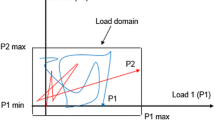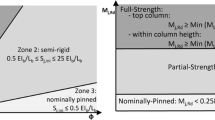Abstract
This work mainly aims to propose a new design procedure combining the benefits of the Performance-Based Plastic Design approach (PBPD) with a rigorous accounting of second-order effects. In fact, by exploiting the kinematic theorem of plastic collapse, second-order effects can be accounted for employing the concept of collapse mechanism equilibrium curve. The same tool constitutes the base of the Theory of Plastic Mechanism Control (TPMC) design approach. Besides, the paper reports a critical comparison between TPMC and PBPD, both having the scope to design structures exhibiting a collapse mechanism of global type. These two approaches are also compared with the refined PBPD where second-order effects are accounted for by the kinematic approach. Many steel moment resisting frames are designed according to PBPD, TPMC and refined PBPD and their performances have been compared on the bases of push-over analyses.
























Similar content being viewed by others
Abbreviations
- \(dv_{k}\) :
-
Vertical virtual displacement occurring at \(k\)th storey
- \(h_{{n_{s} }}\) :
-
Top storey height
- \(h_{1}\) :
-
First storey height
- \(h_{i}\) :
-
Storey height
- \(h_{k}\) :
-
\(k\)th storey height with respect to the foundation level
- \(B_{2}\) :
-
Parameter to account for second-order effects (Eq. 14)
- \(C_{e}\) :
-
Spectral acceleration in the energy balance formulation
- \(d\theta\) :
-
Virtual rotation of column bases
- \(E\) :
-
Energy occurring in an elastic system
- \(E_{e}\) :
-
Earthquake input energy
- \(E_{p}\) :
-
Energy to be dissipated by hysteresis
- \(F_{i}\) :
-
Force acting at the ith storey
- \(F_{k}\) :
-
Seismic force al \(k\)th
- \(g\) :
-
Acceleration of gravity
- \(l_{i}\) :
-
Bay span
- \(M\) :
-
Building mass
- \(M_{b,i,k}\) :
-
Plastic moment in the beam ends when plastic hinge has been developed
- \(M_{{b.jn_{s} }}\) :
-
Plastic moment of \(j\)th beam at the top storey
- \(M_{b.jk}\) :
-
Plastic moment of \(j\)th beam at \(k\)th storey
- \(M_{c} \left( h \right)\) :
-
Moment in the column at the height \(h\) above the ground
- \(M_{c.i1}\) :
-
Plastic moment of \(i\)th column of the first storey reduced due to the simultaneous action of the axial force
- \(M_{pbi}\) :
-
Plastic moment of beams at the ith storey
- \(M_{pbr}\) :
-
Required plastic moment of top storey beams
- \(M_{pc}\) :
-
Required plastic moment of columns at the first storey
- \(M_{ux} \left( h \right)\) :
-
Final bending moment
- \(n_{b}\) :
-
Number of beams
- \(n_{c}\) :
-
Number of columns
- \(n_{s}\) :
-
Number of storeys
- \(P_{cg,i}\) :
-
Gravity load on the column at \(i\)th floor level calculated using the seismic load combination
- \(q_{i,k}\) :
-
Vertical load acting in the seismic load combination
- \(R_{\mu }\) :
-
Reduction factor
- \(S_{v}\) :
-
Spectral velocity of the expected seismic event
- \(S_{v.y}\) :
-
Spectral velocity value corresponding to yielding
- \(T\) :
-
Period of vibration
- \(V\) :
-
Base shear
- \(V_{{n_{s} }}\) :
-
Seismic design shear at the top storey
- \(V_{i}\) :
-
Storey shear at the ith storey
- \(V_{k}\) :
-
Seismic design shear at \(k\)th storey
- \(V_{lk}\) :
-
Concentrated forces acting on columns at the kth storey coming from the inner bays of the column
- \(V_{n}\) :
-
Storey shear at the top storey
- \(W\) :
-
Seismic weight
- \(W_{e}\) :
-
Virtual external work
- \(W_{i}\) :
-
Virtual internal work
- \(W_{k}\) :
-
Total vertical load acting at \(k\)th storey
- \(\Delta /L\) :
-
Maximum target drift
- \(\alpha\) :
-
Rigid plastic analysis collapse mechanism multiplier
- \(\alpha_{{i_{m} }}^{\left( t \right)}\) :
-
First order collapse multiplier of undesired mechanisms
- \(\alpha_{0}^{\left( g \right)}\) :
-
First order collapse multiplier of global mechanism
- \(\alpha_{0}\) :
-
First order collapse multiplier of horizontal seismic forces
- \(\alpha_{coef}\) :
-
Coefficient provided by Eq. (7)
- \(\beta_{i}\) :
-
Shear proportioning factor
- \(\gamma\) :
-
Slope of the mechanism curve accounting for second-order effects
- \(\gamma^{\left( g \right)}\) :
-
Slope of the collapse mechanism equilibrium curve of global mechanism
- \(\gamma_{{i_{m} }}^{\left( t \right)}\) :
-
Slope of the collapse mechanism equilibrium curve of undesired mechanisms
- \(\gamma_{m}\) :
-
Modification factor based on Newmark and Hall studies (Newmark and Hall 1982)
- \(\delta_{i}\) :
-
Step function
- \(\delta_{k}\) :
-
Horizontal displacement occurring at the kth storey
- \(\delta_{u}\) :
-
Ultimate design displacement
- \(\theta_{p}\) :
-
Plastic rotation of dissipative members
- \(\lambda\) :
-
Distribution coefficient lower than 1
- \(\lambda^{*}\) :
-
Updating of the distribution coefficient \(\lambda\)
- \(\lambda_{i}\) :
-
Distribution coefficient
- \(\mu_{s}\) :
-
Structural ductility factor which is equal to target drift divided by yield drift
- MRFs:
-
Moment resisting frames
- PBPD:
-
Performance based plastic design
- TPMC:
-
Theory of Plastic Mechanism Control
- \(\sum\nolimits_{k = 1}^{{n_{s} }} {M_{b,i,k} }\) :
-
Sum of beams plastic moments belonging to the left bay
- \(\sum\nolimits_{k = 1}^{{n_{s} }} {M_{b,i - 1,k} }\) :
-
Sum of beams plastic moments belonging to the right bay
- \(\sum\nolimits_{k = 1}^{{n_{s} }} {S_{i,k} } \delta_{k}\) :
-
Axial forces at the \(k\)th storey in the \(i\)th column at the collapse state from the right bay
- \(\sum\nolimits_{k = 1}^{{n_{s} }} {S_{i - 1,k} } \delta_{k}\) :
-
Axial forces at the \(k\)th storey in the \(i\)th column at the collapse state from the left bay
References
Akiyama H (1985) Earthquake resistant limit state design for building. University of Tokyo Press, Tokyo
Bertero VV, Popov EP (1977) Seismic behaviour of ductile moment-resisting reinforced concrete frames in reinforced concrete structures in seismic zones. ACI Publication SP-53, American Concrete Institute, Detroit, pp 247–291
Bruneau M, Uang CM, Sabelli RSE (2011) Ductile design of steel structures. McGraw-Hill, New York
Cassiano D, D’Aniello M, Rebelo C, Landolfo R, da Silva L (2016) Influence of seismic design rules on the robustness of steel moment resisting frames. Steel Compos Struct Int J 21(3):479–500
Chao S-H, Goel SC (2008) Performance-Based Plastic Design of special truss moment frames. Eng J 45(2):127–150
Chao S-H, Goel SC, Lee S-S (2007) A seismic design lateral force distribution based on inelastic state of structures. Earthq Spectra EERI 23(3):547–569
Dell’Aglio G, Montuori R, Nastri E, Piluso V (2017) A critical review of plastic design approaches for failure mode control of steel moment resisting frames. Ing Sismica 34:82–103
EN 1998-1 (2004) Eurocode 8: design of structures for earthquake resistance—part 1: general rules, seismic actions and rules for buildings. CEN, Brussels
Goel SC, Chao S-H (2008) Performance-Based Plastic Design: earthquake resistant steel structures. International Code Council, Washington, DC
Goel SC, Lee S-S (2001) Performance-based design of steel moment frames using target drift and yield mechanism. Research Report UMCEE 01-17
Goel SC, Liao W-C, Bayat MR, Chao S-H (2010) Performance-Based Plastic Design (PBPD) method for earthquake-resistant structures: an overview. Struct Des Tall Spec Build 19(115):137
Grigorian M, Grigorian C (2012) Performance control: a new elastic-plastic design procedure for earthquake resisting moment frames. J Struct Div ASCE 138(6):812–821
Grigorian M, Grigorian C (2013) An overview on performance control and efficient design of lateral resisting moment frames. Int J High-Rise Build 2(2):141–152
Grigorian M, Kaveh A (2013) A practical weight optimization for moment frames under combined loading. Int J Optim Civil Eng 3(2):289–312
Housner GW (1956) Limit design of structures to resist earthquakes. Proc World Conf Earthq Eng 5:1–11
Isaincu A, D’Aniello M, Stratan A (2018) Implications of structural model on the design of steel moment resisting frames. Open Constr Build Technol J 12(Suppl-1, M6):124–131
Krishnan S, Muto M (2012) Mechanism of collapse of tall steel moment-frame buildings under earthquake excitation. J Struct Eng ASCE 138:1361–1387
Lee S-S, Goel SC (2000) A new lateral force distribution for seismic design of steel structure. In: Proceedings of U.S.–Japan workshop on seismic fracture issues in steel structures, San Francisco, CA
Leelataviwat S, Goel SC, Stojadinovic B (1999) Toward performance based seismic design of structures. Earthq Spectra EERI 15:435–461
Liao W-C, Goel SC (2012) Performance-Based Plastic Design and energy-based evaluation of seismic resistant RC moment frame. J Mar Sci Technol 20(3):304–310
Liao W, Goel S (2014) Performance-based seismic design of RC SMF using target drift and yield mechanism as performance criteria. Adv Struct Eng 17(4):529–542
Longo A, Montuori R, Piluso V (2012) Theory of Plastic Mechanism Control of dissipative truss moment frames. Eng Struct 37:63–75
Longo A, Montuori R, Piluso V (2014a) Theory of Plastic Mechanism Control for MRF–CBF dual systems and its validation. Bull Earthq Eng 12:1–31
Longo A, Nastri E, Piluso V (2014b) Theory of Plastic Mechanism Control: state-of-the-art. Open Constr Build Technol J 8:262–278
Mastrandrea L, Nastri E, Piluso V (2013) Validation of a design procedure for failure mode control of EB-Frames: push-over and IDA analyses. Open Constr Build Technol J 7:193–207
Mazzolani FM, Piluso V (1996) Theory and design of seismic resistant steel frames. E&FN Spon, London
Mazzolani FM, Piluso V (1997) Plastic design of seismic resistant steel frames. Earthquake Eng Struct Dynam 26(2):167–191
Montuori R, Muscati R (2017) Smart and simple design of seismic resistant reinforced concrete frame. Compos B Eng 115:360–368
Montuori R, Sagarese V (2018) The use of steel RBS to increase ductility of wooden beams. Eng Struct 169:154–161
Montuori R, Nastri E, Piluso V (2014) Theory of Plastic Mechanism Control for eccentrically braced frames with inverted Y-scheme. J Constr Steel Res 93:122–135
Montuori R, Nastri E, Piluso V (2016) Theory of Plastic Mechanism Control for MRF-EBF dual systems: closed form solution. Eng Struct 118:287–306
Montuori R, Nastri E, Piluso V, Troisi M (2017) Influence of connection typology on seismic response of MR-Frames with and without ‘set-backs’. Earthquake Eng Struct Dynam 46(1):5–25
Montuori R, Nastri E, Piluso V, Streppone S, D’Aniello M, Zimbru M, Landolfo R (2018) Comparison between different design strategies for Freedam frames: push-overs and Ida analyses. Open Constr Build Technol J 12(Suppl-1, M8):140–153
Newmark NM, Hall WJ (1982) Earthquake spectra and design. Earthquake Engineering Research Institute, El Cerrito
Park R (1986) Ductile design approach for reinforced concrete frames. Earthquake Spectra 2(3):565–619
Paulay T (1977) Seismic design of ductile moment resisting reinforced concrete frames, columns: evaluation of actions. Bull N Z Natl Soc Earthq Eng 10:85–94
Paulay T (1979) Capacity design of earthquake resisting ductile multistorey reinforced concrete frames. In: Proceedings of the 3rd Canadian conference on earthquake engineering, Montreal, vol 2, pp 917–948
Paulay T (1980) Deterministic design procedure for ductile frames in seismic areas. ACI Publication SP-63, American Concrete Institute, Detroit, pp 357–381
Piluso V, Nastri E, Montuori R (2015) Advances in Theory of Plastic Mechanism Control: closed form solution for MR-Frames. Earthquake Eng Struct Dynam 44(7):1035–1054
Piluso V, Pisapia A, Castaldo P, Nastri E (2019) Probabilistic Theory of Plastic Mechanism Control for steel moment resisting frames. Struct Saf 76:95–107
Salmon CG, Johnson JE (1990) Steel structure: design and behaviour. Harper Collins, New York
Tartaglia R, D’Aniello M, De Martino A, Di Lorenzo G (2018) Influence of EC8 rules on P-delta effects on the design and response of steel MRF. Ing Sismica 35(3):104–120
Tenchini A, D’Aniello M, Rebelo C, Landolfo R, da Silva LS, Lima L (2014) Seismic performance of dual-steel moment resisting frames. J Constr Steel Res 101:437–454
Vigh LG, Zsarnóczay A, Balogh JM, Castro JM (2016) P-delta effect and pushover analysis: review of Eurocode 8-1. Report N.1 of WG2 CEN/TC 250/SC 8, 2/2/2016
Author information
Authors and Affiliations
Corresponding author
Additional information
Publisher's Note
Springer Nature remains neutral with regard to jurisdictional claims in published maps and institutional affiliations.
Rights and permissions
About this article
Cite this article
Dell’Aglio, G., Montuori, R., Nastri, E. et al. Consideration of second-order effects on plastic design of steel moment resisting frames. Bull Earthquake Eng 17, 3041–3070 (2019). https://doi.org/10.1007/s10518-019-00573-9
Received:
Accepted:
Published:
Issue Date:
DOI: https://doi.org/10.1007/s10518-019-00573-9




